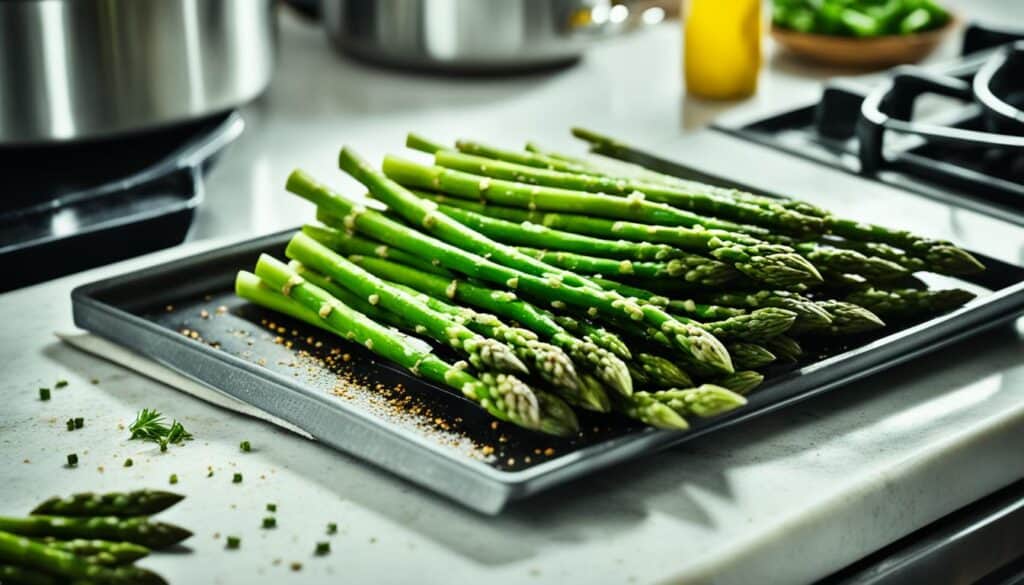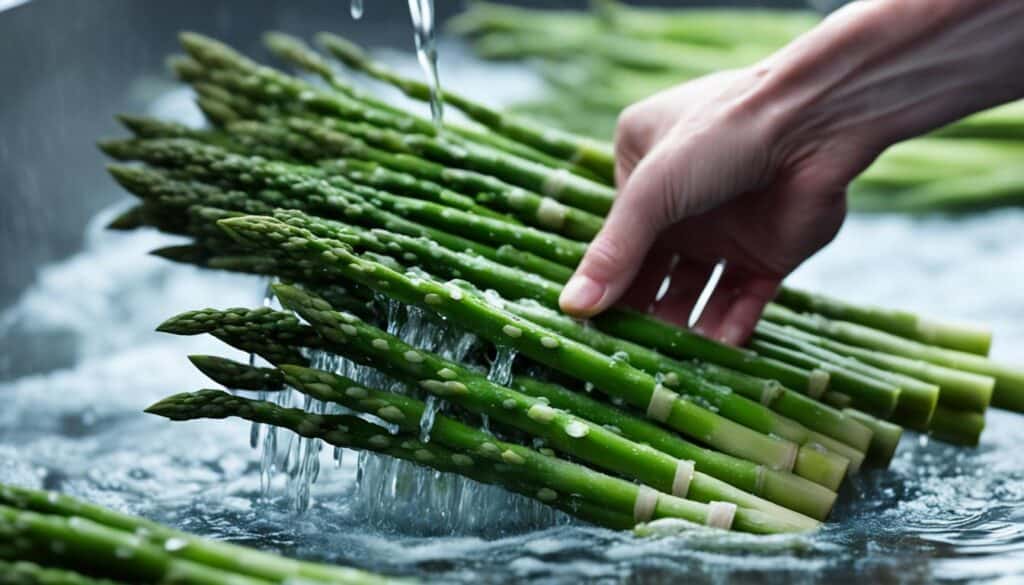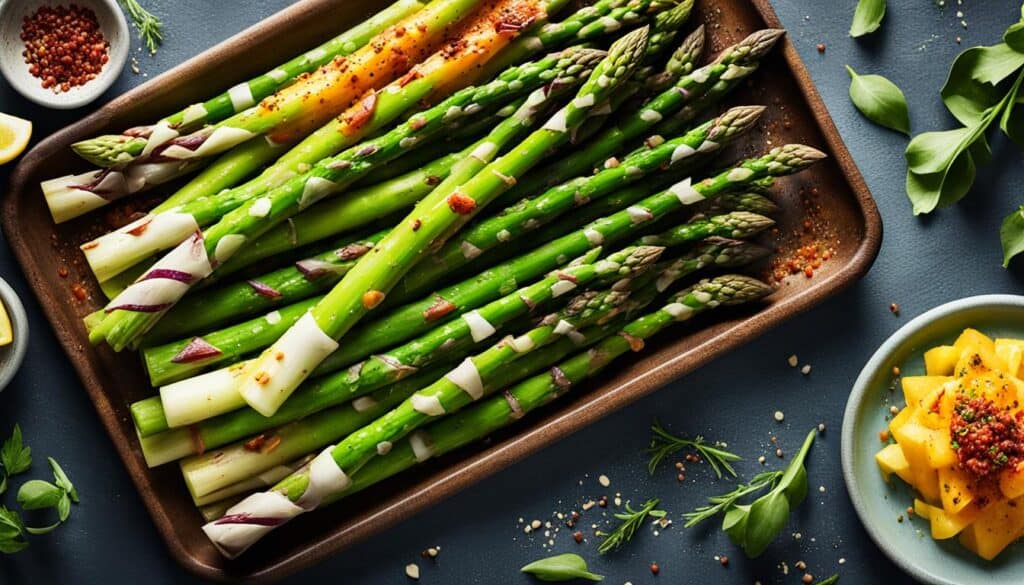Did you know that roasting asparagus brings out its best flavors, with the tips getting crispy and the flavor becoming more concentrated compared to other cooking methods? This simple technique can elevate your asparagus game and make it the star of any springtime meal. Whether you’re a seasoned chef or a beginner cook, learning how to roast asparagus to perfection is an essential skill worth mastering.
How to Store and Prep Asparagus
When it comes to enjoying the freshness of asparagus for several days, proper storage is essential. Follow these simple steps to store asparagus and keep it at its best:
- Place the asparagus upright in a heavy-bottomed jar or drinking glass.
- Add a few inches of water to the container, ensuring the bottoms of the stalks are submerged.
- Cover the asparagus with a plastic bag to retain its freshness.
This storage method helps maintain the crispness and flavor of asparagus for a longer duration.
Now, let’s move on to prepping asparagus. Here’s how to do it:
- Hold the asparagus stalk firmly with one hand.
- With your other hand, gently bend the stalk until it naturally breaks.
- Discard the tough end that snapped off, as it is not as tender as the rest of the stalk.
Prepping asparagus can also be a fun activity to involve your kids at dinnertime. They’ll enjoy snapping off the tough ends and participate in the meal preparation process.
Storing and Prepping Asparagus
| Step | Storing Asparagus | Prepping Asparagus |
|---|---|---|
| Method | Place asparagus in a jar with water | Bend stalks until they naturally break |
| Duration | Several days | N/A |
Following these simple steps for storing and prepping asparagus will ensure that you have fresh, tender stalks ready for cooking. Now that your asparagus is stored and prepped, it’s time to move on to the next step: roasting!
How to Roast Asparagus
Roasting asparagus is a simple and quick process that brings out the natural flavors of this delicious vegetable. Here’s a step-by-step guide on how to roast asparagus to perfection.
1. Preheat your oven to 425 degrees Fahrenheit.
2. Start by preparing the asparagus. Snap off the tough ends by bending the stalks until they naturally break in the right place. This ensures that you remove the woody parts and keep the tender portion.
3. Place the prepared asparagus on a parchment-lined baking sheet.
4. Drizzle the asparagus with a generous amount of olive oil, making sure each piece is coated evenly.
5. Season with salt and pepper to taste. You can also experiment with other seasonings like garlic powder, paprika, or herbs such as thyme or rosemary.
6. Gently toss the asparagus to ensure that the oil and seasonings are well distributed.
7. Arrange the asparagus in a single layer on the baking sheet. This allows the asparagus to roast evenly and develop a nice caramelized exterior.
8. Place the baking sheet in the preheated oven and roast the asparagus until they are tender and slightly charred. The cooking time can vary depending on the thickness of the asparagus spears. Pencil-thin asparagus usually take around 10 minutes, while thicker spears may need 15-20 minutes.
9. To check if the asparagus is done, carefully pierce a spear with a fork. It should be easily pierced but still have a slight crunch.
10. Once roasted to perfection, remove the asparagus from the oven and serve immediately.
Roasted asparagus makes a fantastic side dish for any meal. Its rich and nutty flavor pairs well with a variety of main courses. Try it with roasted chicken, grilled steak, or fish for a delicious and wholesome meal.
Seasoning Ideas for Roasted Asparagus
Roasted asparagus is a versatile dish that can be customized with a variety of seasonings to enhance its flavor. Here are some delightful ideas to season your roasted asparagus:
- Lemon Zest or Lemon Wedges: Add a refreshing citrusy twist to your asparagus by sprinkling it with lemon zest or serving it with lemon wedges.
- Grated Parmesan Cheese: Create a rich and savory flavor by grating some Parmesan cheese over your roasted asparagus. This adds a delightful creamy touch to each bite.
- Chopped Fresh Mint or Parsley: For a burst of freshness, garnish your roasted asparagus with some chopped mint or parsley. These herbs lend a vibrant and aromatic element to the dish.
- Red Pepper Flakes: If you prefer a bit of heat, sprinkle some red pepper flakes over your roasted asparagus. This adds a subtle kick that complements the natural sweetness of the asparagus.
- Butter: Indulge in a touch of richness by adding a pat of butter to your roasted asparagus. The buttery goodness melts into the stalks, enhancing their natural flavors.
- Balsamic Reduction or Thick Balsamic Vinegar: Drizzle your roasted asparagus with a tangy balsamic reduction or thick balsamic vinegar. This adds a sweet and slightly acidic note that pairs perfectly with the earthiness of the asparagus.
- Toasted Sliced Almonds: For a delightful crunch, sprinkle some toasted sliced almonds over your roasted asparagus. The nutty flavor complements the roasted notes and adds an enjoyable texture.
These seasonings can elevate the flavor profile of your roasted asparagus, transforming it into a delectable side dish. Feel free to mix and match these ideas or experiment with other seasonings to create your own unique combination.
Tips for Perfectly Roasting Asparagus

When it comes to roasting asparagus, there are a few tips and tricks to ensure you achieve perfect results every time. Here are my top tips for roasting asparagus:
- Choose the right asparagus stalks: Opt for thinner stalks as they tend to crisp up better while roasting. Meatier stalks, on the other hand, are better suited for grilling.
- Select firm asparagus: Look for asparagus with a bit of give when gently squeezed. Avoid limp stalks as they may not roast evenly.
- Trim the woody ends: Cut off the tough, fibrous ends of the asparagus stalks to ensure a tender bite.
- Avoid overcrowding the pan: Arrange the asparagus in a single layer on the baking sheet. This allows for even cooking and prevents steaming.
- Set the oven temperature: Preheat the oven to 425 degrees Fahrenheit for optimal roasting.
- Adjust cooking time: The roasting time will vary depending on the thickness of the asparagus. Thinner stalks will take around 10 minutes, while thicker stalks may need 15-20 minutes. The asparagus should be tender and easily pierced with a fork when done.
By following these tips, you’ll be able to roast asparagus to perfection, achieving a deliciously crispy yet tender texture with every bite.
Customer Feedback:
“I never knew that choosing the right asparagus stalks could make such a difference in the roasting process. Thanks for sharing these helpful tips!” – Sarah
“The tip about not overcrowding the pan really changed the game for me. My roasted asparagus turned out so much better after making that adjustment.” – Mark
| Tip | Details |
|---|---|
| Choose the right asparagus stalks | Thinner stalks crisp up better when roasted. |
| Select firm asparagus | Look for asparagus with a bit of give. |
| Trim the woody ends | Cut off the tough, fibrous ends of the asparagus stalks. |
| Avoid overcrowding the pan | Arrange the asparagus in a single layer. |
| Set the oven temperature | Preheat the oven to 425 degrees Fahrenheit. |
| Adjust cooking time | Vary the roasting time based on the thickness of the asparagus stalks. |
Additional Recipes Using Asparagus

If you have extra asparagus, there are many delightful recipes that can help you unleash its full potential. Explore these easy and delicious asparagus recipes to make the most of this versatile vegetable.
1. Asparagus Lemon Risotto
Indulge in a creamy and tangy asparagus lemon risotto that combines the earthy flavors of asparagus with the bright notes of lemon. This recipe balances richness and freshness for a satisfying meal. Serve it as a main course or as a side dish to complement grilled chicken or fish.
2. Asparagus with Lemon and Feta
Add a burst of flavor to your asparagus with this simple yet impressive recipe. Roast the asparagus until tender and slightly crispy, then sprinkle it with crumbled feta cheese and a generous squeeze of lemon juice. The combination of salty feta and zesty lemon creates a tantalizing taste experience that pairs perfectly with roasted meats or a light pasta dish.
3. Roasted Asparagus in Salads or Pasta Dishes
Take your salads and pasta dishes to the next level by incorporating roasted asparagus. Toss it with mixed greens, cherry tomatoes, and a tangy vinaigrette for a refreshing salad. Alternatively, add it to your favorite pasta dish with some sautéed garlic, cherry tomatoes, and a sprinkle of Parmesan cheese for a satisfying and flavorful meal that celebrates the season’s harvest.
These easy asparagus recipes offer a variety of ways to enjoy this nutritious vegetable. Whether you’re looking for a comforting risotto, a vibrant salad, or a flavorful pasta dish, these recipes are sure to impress. Get creative in the kitchen and showcase the versatility of asparagus with these delicious dishes.
How to Cook Perfect Asparagus Every Time

Cooking asparagus to perfection involves using the right technique. One method that guarantees excellent results is to blanch the asparagus in boiling water for exactly 2 minutes and then immediately transfer it to an ice bath to halt the cooking process. This technique ensures that the asparagus retains its vibrant color, crisp texture, and tender bite. The blanched asparagus can be used in various dishes, from salads to stir-fries, and can even be enjoyed on its own as a tasty and nutritious snack.
Blanching is not only limited to asparagus; it can also be applied to other vegetables like green beans or pea pods. By blanching vegetables, you can enhance their natural flavors, preserve their nutrients, and achieve the perfect level of doneness.
The Benefits of Blanching
Blanching is a versatile cooking technique that offers several benefits:
- Preserves Color: Blanching helps retain the vibrant green color of asparagus, ensuring an appetizing presentation.
- Ensures Crispness: By briefly cooking the asparagus in boiling water and then shocking it in cold water, blanching prevents overcooking and maintains a pleasing crispness.
- Locks in Nutrients: Blanching quickly cooks the asparagus, preserving its nutrients and vitamins.
- Enhances Flavor: The brief cooking time of blanching helps concentrate the flavors of the asparagus without dulling its natural taste.
How to Blanch Asparagus
Follow these simple steps to perfectly blanch asparagus:
- Prepare an ice bath by filling a large bowl with cold water and adding ice cubes.
- Bring a pot of water to a rolling boil. Add a pinch of salt to enhance the flavor.
- While the water is heating, trim the tough ends off the asparagus spears.
- Add the trimmed asparagus to the boiling water and cook for exactly 2 minutes.
- Using tongs or a slotted spoon, remove the blanched asparagus from the boiling water and immediately transfer it to the ice bath.
- Let the asparagus sit in the ice bath for a few minutes to cool and stop the cooking process.
- Once chilled, remove the asparagus from the ice bath and pat it dry with a clean kitchen towel or paper towel.
- Your perfectly blanched asparagus is now ready to be used in your favorite recipes!
Blanched asparagus can be enjoyed cold in salads or as a crunchy snack. It can also be quickly sautéed or grilled to add a touch of smokiness and extra flavor. The blanching technique opens up a world of culinary possibilities, allowing you to savor the natural goodness of asparagus in a variety of dishes.
Best Ways to Serve Roasted Asparagus

Roasted asparagus is a delightful dish that can be enjoyed in various ways. The caramelized flavor and tender texture of the roasted asparagus make it a perfect accompaniment to a range of main dishes or a delicious snack on its own. Here are some suggestions for serving roasted asparagus:
- Pair it with lamb for an elegant and flavorful meal.
- Serve it alongside grilled fish to add a pop of color and freshness to the plate.
- Combine it with chicken for a nutritious and well-rounded dish.
- Enjoy it as a side to a juicy steak for a delicious combination of flavors and textures.
- Incorporate it into a pork dish to add a vibrant and earthy element.
Roasted asparagus also shines on its own as a light and flavorful snack. Its natural sweetness and rich umami flavors make it a satisfying treat. Additionally, you can use roasted asparagus to enhance other dishes:
- Add it to salads for a burst of freshness and a nutrient boost.
- Toss it with pasta for a simple yet flavorful meal.
- Mix it into risotto to create a creamy and comforting dish.
With roasted asparagus, the possibilities are endless. Its versatility allows you to get creative and experiment with different flavors and preparations. Whether you’re looking for a side dish, a main course, or a unique ingredient to elevate your recipes, roasted asparagus is a fantastic choice.
Conclusion
Cooking asparagus is a delightful culinary adventure that allows you to savor the vibrant flavors of this versatile vegetable. By mastering the art of roasting asparagus, you can unlock its full potential and create mouthwatering dishes that will impress both family and friends. Storing and prepping asparagus correctly is key to preserving its freshness and ensuring a delicious outcome.
When it comes to roasting asparagus, remember to arrange the spears on the baking sheet in a single layer, allowing them to bask in the oven’s heat and develop a tantalizing crispness. Avoid overcrowding the pan, as this can impede the roasting process. Experiment with different seasonings like lemon zest, grated Parmesan cheese, or a drizzle of balsamic reduction to enhance the flavor profile of your dish.
Don’t limit yourself to roasting alone, as asparagus can be a star ingredient in various recipes. Whether you’re whipping up a refreshing salad, a comforting risotto, or a hearty pasta dish, asparagus can lend its unique taste and vibrant color to create memorable meals. Expand your culinary repertoire and explore the endless possibilities of incorporating asparagus into your cooking.
With the tips and techniques shared in this article, you now have the tools to cook asparagus to perfection every time. Embrace the joy of cooking with asparagus, experiment with new recipes, and let your culinary creativity shine. Whether you’re a beginner or an experienced home chef, the world of asparagus recipes awaits, ready to be explored.





Leave a Reply